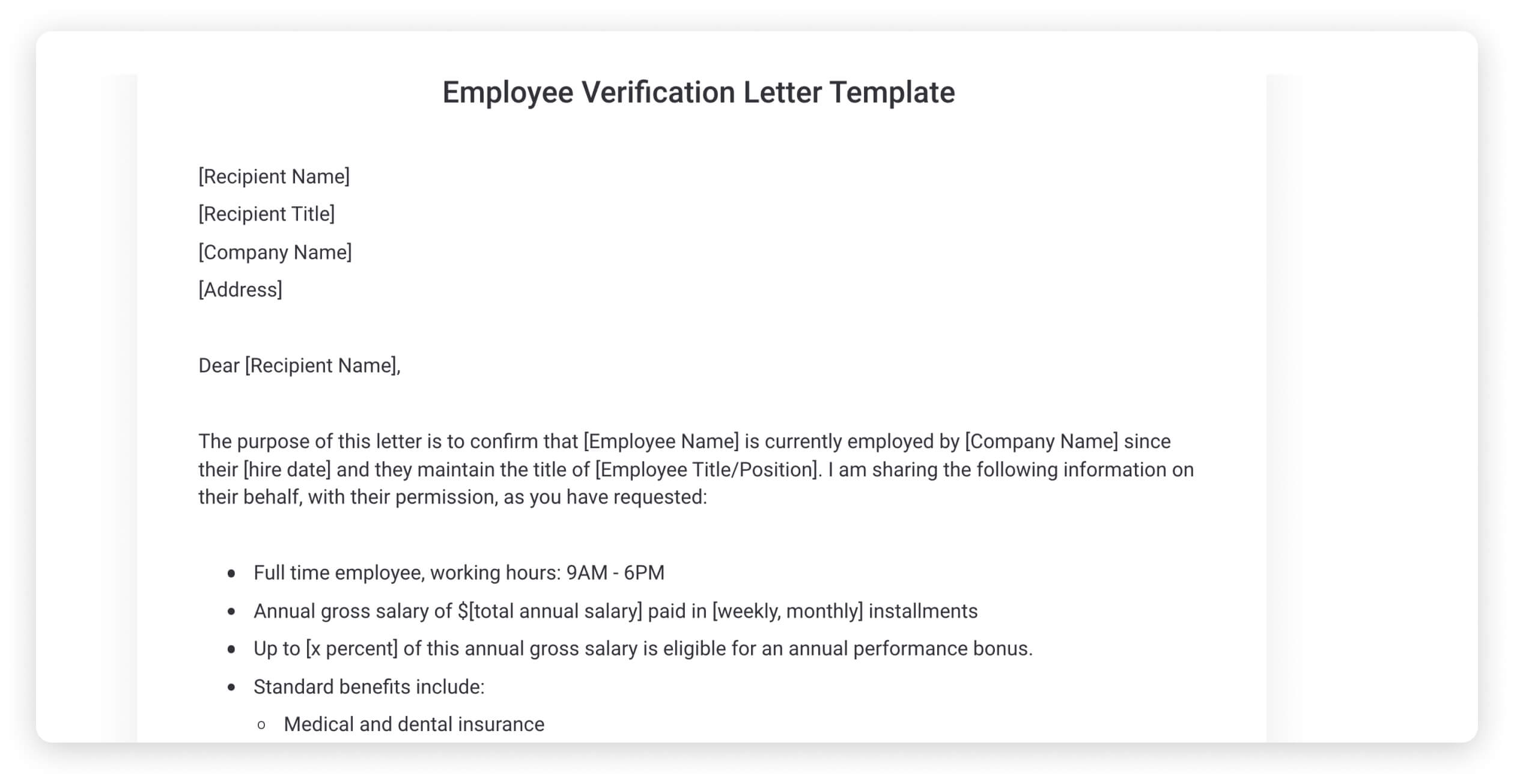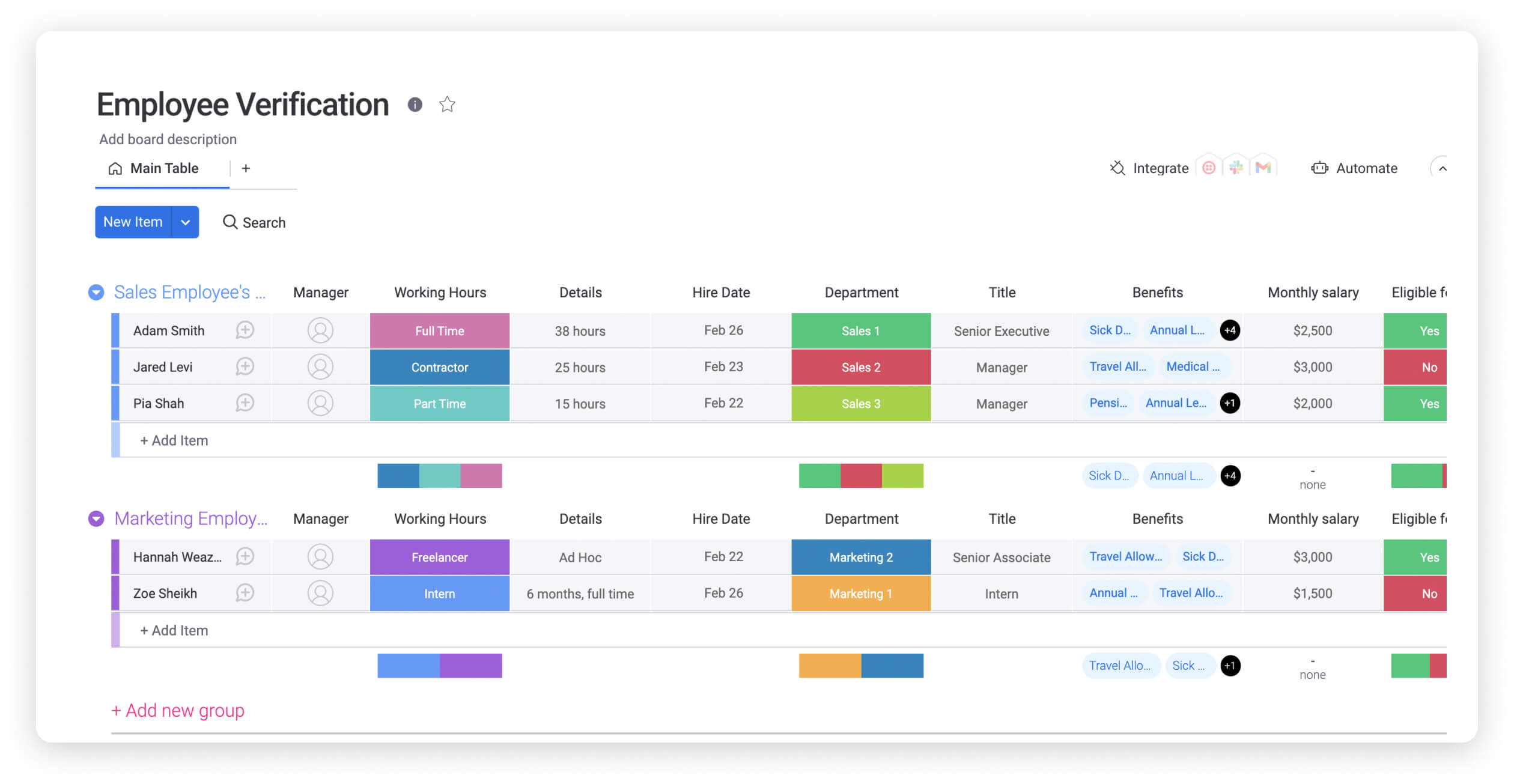Employees request employment verification letters for many different reasons, whether it’s to rent a new apartment, secure a loan from the bank, or even to move on to another job where they need to provide this information as part of the hiring process.
In any of these cases, writing an employment verification letter can be made much simpler and faster by starting with a template that covers all the necessary fields. In this article, we’ll tell you what employment verification templates are and why they’re used. We’ll also give you a top-class template to use, so you don’t have to break a sweat creating one from scratch.
What is an employment verification letter template?
Let’s start with the basics — what exactly is an employment verification letter?
An employment verification letter (EVL) outlines an employee’s past or current employment status with a company. An employment verification letter template provides suggested fields for you to include to make sure you cover all the information you’re likely to need.
Here are some details you can include in an employment verification letter:
- Job title
- Salary
- Contact details, such as residential address and phone number
- Salary growth
- Assessment of job performance
- Roles and responsibilities
Why is an employment verification letter needed?
Employment verification letters (EVL) are used as proof of a stable level of income. Lending institutions usually require them to reduce their risk before issuing mortgages or loans. Landlords may require them for rental purposes. Governmental agencies may also ask for them for visa purposes.
Other names for EVLs include:
- Income Verification Letter
- Employment Confirmation Letter
- Salary Verification Letter
- Work Verification Letter
- Proof of Employment Letter
Why use an employment verification letter template?
If you know you need to provide an employment verification letter but you’re not sure what information is required, using a template can be a quick win. Here are the main benefits of using an employment verification template:
- They save time. Creating an employment verification letter from scratch is challenging. You first have to research what goes into your letter and then have to verify if you’ve got all the necessary details included. After that, you’ve to make sure you’ve phrased sentences correctly and have come up with the proper paragraph structure.
An employment verification template saves you the hassle because it provides a useful outline and a vehicle for filling in your employee details.
- They prevent costly mistakes. Employees request EVLs to obtain loans, get visas approved, and secure new apartment rentals. Any errors in an EVL could lead to a rejection of the employee’s application.
Using a quality template helps you avoid these errors. Which means you don’t have to manage the fallout if your employee’s application is rejected.
- They come with the perfect layout. Creating employment letters from scratch will leave you wondering if you’ve structured the letter correctly. To save you from that nagging sense of worry — or having to go back later and correct your mistakes — use professional templates that come with an optimal structure and layout.
- They offer consistency. Templates from a single source ensure the style remains consistent throughout all documents. This is crucial when you want uniformity in your company’s documentation process.
What are some examples of employment verification letters?
As we mentioned above, there are a number of different scenarios when an EVL may be requested. Let’s run through a few of them and take a look at a few employment verification letter samples.
Employment verification letter for applying for a job
A company may be impressed by your former employee’s job interview and be eager to hire them. But they need to make sure the employee has provided an accurate employment history, so they ask for an EVL from the employee to confirm their previous work history and salary.
In such EVLs, you need to highlight details like:
- Employee’s qualifications
- Job title
- Description of responsibilities
- Annual compensation (yearly or monthly payments)
Employment verification letters for renting a home
Tenants who don’t pay on time can cause a lot of stress. It’s hard for landlords to sort a punctually-paying tenant from a tardy one through word-of-mouth alone. Occasionally, prospective tenants may even provide fake business names or salaries to dupe landlords. In these cases, employment verification letters help landlords confirm employment and salary details and reduce their risk.
If you’re a landlord and want to request an EVL from a prospective tenant, make sure you ask for at least the following details:
- Employee hiring date
- Job title
- Employee classification (part-time, full-time, temporary, contract)
- Annual compensation
Here’s an example of what that could look like:

Employment verification letters for mortgages or loans
Banks are also in the risk management game. They’ll want to know if your employee can pay their mortgage or loans on time. A verification of employment letter and copies of an employee’s pay stubs, make them feel more confident when signing that loan or mortgage.
When writing to the bank, let them know the following:
- Employee’s annual compensation
- Job title
- Classification
- Hiring rate
Employment verification letters for visa application
Government agencies often ask for employment verification for various purposes. Some use cases include visa applications (H1B, tourist visa), tax purposes, or completing certain federal records.
EVLs sent to these agencies must include:
- Employment dates (start and end dates)
- Job title
- Employee classification
- Annual compensation
- Description of responsibilities
Here’s an example of an employment verification letter that would work for most of the above scenarios. If the institution requires details on the employee’s responsibilities, you can add a copy of their job description.

monday.com’s employment verification letter template
monday.com has 200+ ready-made templates that are easy to use and built to support real businesses, just like yours. Whether a landlord, government agency, or company requests an EVL from your employee, our employment verification letter template can be easily customized to fit.

Our Work OS allows you to pull data from the employee’s profile and populate the EVL template in no time. You can also share the template with anyone in the organization with just a few short clicks. Plus, our intuitive “if that, then this” automations make keeping on top of administrative work simple. Use them to track employment verification requests, set deadline reminders, and keep tasks moving through the workflow.

Want to access verification letters from all employees in one dashboard and keep track of past EVLs? monday.com makes that oh so easy for you. And with everything you need to get work done being managed in a single shared workspace, document management remains simple and secure.
Related templates
Business letter format
In an age where communication is mostly casual, business letters are a professional way to engage businesses, employees, clients, and stakeholders. Each business letter must have a clear purpose for writing and a call to action. These letters should ideally be less than a page long and should be thoroughly proofread.
Here’s the general outline of a business letter:
- Your contact information
- The recipient’s contact information
- Date
- Salutation
- Body
- Closing
- Signature
Job application template
Prospective employees often fill out job application forms when applying for a new position.
They’re expected to fill in details like:
- Personal information
- Past work history
- Skills and certifications
- Any additional information that’s relevant to the employer
Employers often use these forms in the hiring process to gain a quick overview of different applicants and narrow down the best ones. Here’s an example of a form on monday.com.

Background check template
Companies and organizations use background checks to verify an applicant’s background and history. Employers frequently conduct these checks when hiring new employees. Landlords do the same when taking in new tenants.
The benefit of a background check template is that organizations can quickly and easily gather the data they need to make an informed choice about an applicant.If you sign a background check authorization form, you give consent to an organization to conduct a thorough background check. This may include information on your employment history, financial obligations, and criminal record.
Here are common fields in a background check authorization template:
- Name of the applicant
- Address
- Telephone Number
- Current and previous employment
- Social security number
- Education History
FAQs about an employment verification letter template
What is an employment verification form?
As well as an employment verification letter, you may also hear of something called an employment verification form. This is an alternative to an EVL that may be used by a company HR department to collect the same information required in an employment verification letter. Depending on their process, they can then use this information to create a separate EVL or add it as an attachment to a covering letter.
How do I get an employment verification letter from my employer?
To get an employment verification letter, you need to ask your human resources (HR) department or your manager for one. Usually, HR will prepare the letter, and all you need to do is enter your signature. In other cases, you may be required to fill out a form and then get the company to sign and approve it.
Can I write my own employment verification letter?
Yes, you can write your own employment verification letter. However, you’d need to get the signature of your employer to make it official. It’s generally advisable to ask your employer to write the letter rather than the other way round. If you’re going to write your own letter, using our comprehensive template is a great place to start.
How do employers do employment verification?
Employers check previous employment by contacting the workplace where an employee worked previously. They then verify a candidate’s job title and dates of employment. Asking the candidate to submit an employment verification letter replaces the need for contacting the previous employer directly.

